Archaeology and the Bible
Kings and Chronicles - 3
| Nippur | 32 07 37.61N 45 13 40.02E | Unusually there are no photographs of this tel, yet it is 60' high with a prominent ziggurat and almost a mile in diameter! The picture is not clear enough to make out any details. |
| Nineveh | 36 20 52.03N 43 09 35.56E | The shape of the ancient city can be clearly seen for the modern settlement is largely confined within the ancient walls. Only in the south-east do the walls still stand uncluttered by modern buildings. |
| Babylon | 32 32 33.52N 44 25 16.70E | The modern canal outlines the extent of the ancient city. The three huge mounds were constructed by Saddam Hussein as part of his plans to turn Babylon into a Disney-land style entertainment park. The ruins of the temples and palaces can be clearly seen. |
Assyrian Exile
The final end for the northern kingdom came with the accession of the Assyrian king Tiglath-pileser III, who undertook a vigorous campaign of expansion into Syria and Palestine. Menahem was obliged to pay a bribe of 1,000 talents of silver to "Pul" to be allowed to keep his throne - and recovered the money in a most insulting way, but demanding that every wealthy man in the kingdom pay 50 silver shekels. According to cuneiform documents, this was the average price for a slave!
In his record for the year 743 BC Tiglath-pileser III notes:
As for Menahem, I overwhelmed him like a snowstorm and he fled like a bird alone and bowed at my feet. I returned him to his place and imposed tribute upon him.
In another document Tiglath-pileser III boasts of his various conquests in that same year:
I received tribute from Kustashpi of Commagene, Rezon of Damascu, Menahem of Samaria, Hirm of Tyre, Sibitti-bi'li of Byblos, Urikki of Que, Pisiris of Carchemish, I'nil of Hamath ...
Rezon of Damascus is the same as the Rezin mentioned by Isaiah, whose alliance with Pekah of Israel was so threatening to Judah. God, through Isaiah, promised deliverance to Ahaz and offered to give him a sign that the promise was trustworthy. When the disbelieving Ahaz demured, Isaiah announced the sign that God would give: a virgin would give birth to a son and before the child was old enough to know good from bad, both Rezin and Pekah would be no more.

| |
| A bulla impressed with the seal of King Ahaz. On the back can be seen the impression of the papyrus document to which it was affixed. At one edge is a fingerprint - possibly that of Ahaz himself. The inscription reads, "Belonging to Ahaz, son of Jotham, king of Judah". |
According to Thiele, Ahaz was co-regent with his father from 736/5 onwards, perhaps because of some sickness or disability suffered by Jotham. As Jotham had been a successful ruler, conquering the Ammonites and erecting fortifications throughout Judah, Rezin and Pekah took advantage of this sickness or disability to make a treaty and take action to curb the growing power of their southern neighbour. Ahaz suffered several severe reversals, for his army was slaughtered and large numbers of civilians were taken away as captives, so the promise made to him should have been welcome.
In fact he had a plan of his own, which was to bribe the Assyrians to attack his enemies - and Tiglath-pileser required no second invitation. In 734 he laid siege to Damascus and left part of his army there while with the rest of the army he invaded Israel, forcing Pekah to take refuge in Samaria. In 732 BC Tiglath-pileser III captured Damascus and sacked it and in the same year Pekah was assassinated by a usurper. Ahaz became sole ruler in 732/1 and must have felt very satisfied with the success of his plan - little realising that he had drawn the attention of the Assyrians to the wealth of his kingdom!
Tiglath-pileser actually mentions Ahaz in his annals, boasting that he received tribute from him - the bribe to which the Bible refers. The most interesting thing is that the Assyrian king refers to him as "Yehoahaz", a name which incorporates the name of God. It would seem that his father gave him a name that recognised God, but Ahaz himself, when he came to the throne, dropped the part that identified him as a servant of Yahweh.
As well as the seal of Ahaz himself, shown in the picture above, we have also found a seal belonging to one of his officials. The inscription on this seal, which is cut into a carnelian, reads, "For Asna, servant of Ahaz". Unlike his master, who was satisfied with a simple inscription, Asna's seal - which appears to have been made by Egyptian craftsmen - is decorated with a sun disk with ram's horns and a uraeus hanging from each horn, plus three Osiris crowns.
The northern kingdom ended in August or September 722 BC when Sargon II brought the three-year siege of Samaria, started by his predecessor Shalmaneser V, to a sucessful conclusion. On the wall of his palace at Dar-Sharrukin (modern Khorsabad) Sargon recorded:
In my first year of reign the people of Samaria to the number of 27,290 ... I carried away. Fifty chariots for my royal equipment I selected. The city I rebuilt. I made it greater than it was before. People of the lands I had conquered I settled therein. My official I placed over them as governor.
It would appear, however, that the northern tribes were not immediately removed. In his first two years Sargon was engaged in establishing his hold on the throne and after that he had to deal with trouble in Babylonia. There is a suggestion that the people of the northern kingdom took the opportunity to cause trouble and it was this that decided Sargon to deport them.
This was entirely in line with official Assyrian policy. Partly it was to break up any national feeling and so incorporate the captives in the Assyrian empire; partly it was to separate the people from their gods (which were believed to be tied to a particular locality) and thus render them weak and helpless. Unlike the southern kingdom, the Jews of the northern kingdom were wedded to the worship of gods other than Yahweh, so there was nothing to hold them together. They appear to have assimilated with the lands to which they were taken and attempts to identify them have failed. The ten lost tribes remain lost to this day.
In the 1700s when Britain's consciousness of itself as a champion of Protestantism was growing, the idea sprang up that the British were special because they were, in fact, the descendants of the Lost Tribes. The evidences claimed in support of this belief may have been convincing to earlier generations but increased knowledge has removed all plausibility from these arguments. Modern genetics has proved that there is no link between Jews and Anglo-Saxons.
Although the exiles were taken to Guzana and Haran, it is possible that they were not rigidly confined there, for ostraca found at Nimrud and Nineveh bore Israelite names such as Menahem and Hoshea.
Hezekiah
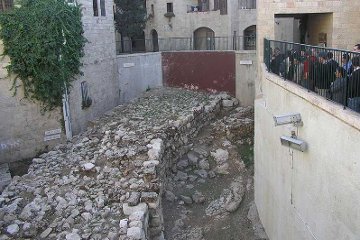
| |
| The Broad Wall is surrounded by the buildings of the Modern Jewish Quarter in the Old City of Jerusalem. |
Shortly after Israel conquered Jerusalem the Jewish Quarter began to be rebuilt. In the course of this rebuilding a lot of archaeological work was undertaken and Nahman Avigad uncovered a 210' long stretch of wall that still remained standing to a height of 10' in places. Well built of relatively small stones, the wall is approximately 25' thick, which earned it the name of "the Broad Wall".
The position and direction of the Broad Wall indicate that during the reign of Hezekiah Jerusalem outgrew the City of David and began to expand onto Mount Zion on the other side of the Tyropoean Valley. It would appear that Hezekiah built the Broad Wall to provide defences for this part of the city and the wall's width is probably because it faced north and was not strengthened by the natural defences of steep hillsides which protected the rest of the city.
The effect of this spread of the city was that the Tyropoean Valley was inside the walls for the first time and that enabled Hezekiah to bring the water from the spring Gihon into the city. He could have dug a channel around the foot of the hill, but that would have been too easy for an attacker to locate and interrupt, so instead he set his workmen to dig a tunnel right under the city, from the east to the west.
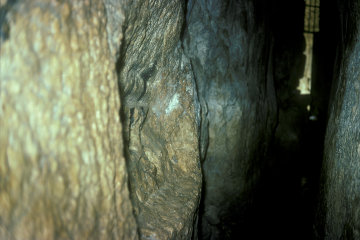
| |
| The hole in the rock near the end of Hezekiah's Tunnel from which the famous inscription was stolen. |
As an engineering feat it was very impressive; as an example of ancient surveying techniques it was less so. The tunnel follows a winding course under the hill and although some have suggested that the excavators were following a natural channel or avoiding areas of hard rock, the simplest answer is that they kept losing their way. In fact, in several places the tunnel turns sharply, leaving a blind passage a couple of feet long, showing that for some reason the workmen realised they were heading the wrong way and needed to change direction. A recent suggestion is that people up above listened to the sound of the digging coming up through the earth and were able to guide the diggers in that way - an imprecise method which may account for the bends and twists in the tunnel.
Another indication of inadequate surveying is the fact that at its start the tunnel is only five feet high, but at the end it is nearly 20' high. Presumably the workmen at the Siloam end started digging at the higher level, but when they met up with the workmen from the Gihon end they discovered that they were too high and had to dig down deeper to get the water to flow.
There are pick marks on the wall which show that there were two teams of workmen, a deduction which is confirmed by an inscription cut into the side of the tunnel about 19' from the Siloam end. Discovered in 1890 by two boys who were playing in the tunnel, the inscription was examined and cleaned (with acid!) of limescale which had obscured it, but in 1891 it disappeared: someone had cut it from the wall and removed it. (The hole where it used to be is still there, though the Israelis have recently put a replica of the inscription on the wall next to the hole.)

| |
| The Siloam Inscription in the Istanbul Museum. |
A few months later it was discovered in the house of a Greek antiquities dealer, badly broken. The man naturally claimed that he didn't know what it was and hadn't a clue about how it got into his house, but there is little doubt that he had instigated the theft. As the Ottoman Empire ruled in Palestine at the time, the stone was taken to Istanbul where it remains. The inscription, which is incomplete, reads as follows:
... the tunnel ... and this is the story of the tunnel while ... the axes were against each other and while three cubits were left to cut ... the voice of a man ... called to his counterpart, for there was crack in the rock, on the right ... and on the day of the tunnel being finished the stonecutters struck each man towards his counterpart, axe against axe and flowed water from the source to the pool for 1200 cubits. and 100 cubits was the height over the head of the stonecutters ...
This has been understood to mean that the excavators worked from both ends ("axes against each other") and while still 5' apart could hear each other through a crack (zada, an unknown word) in the rock. Following the crack, which was on the right, they were able to complete the work and successfully meet the other gang of workmen. This is confirmed by the fact that the join is more or less a right-angle.
Taylor Prism
I have already mentioned the inscription by Sennacherib carved between the legs of a winged bull and brought back by Layard. In 1830 a Colonel Taylor conducted some excavations at Nineveh and discovered a six-sided clay prism whose panels were filled with closely written cuneiform. He
brought it back to Britain, where it was discovered to be the account of Sennacherib's first eight campaigns and an almost identical copy of the first inscription. When Taylor died twenty years later the British Museum purchased the prism and it is now in the Museum.
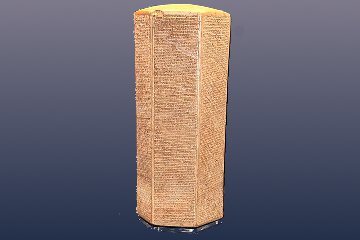
| |
| The Taylor Prism contains the account of Sennacherib's first eight campaigns. |
In 1919 James Breasted bought another prism from a Baghdad antiques dealer, which is now in the Oriental Institute of Chicago and contains a near identical copy. There is another copy in the Israel Museum and fragments of other copies have been found elsewhere. According to the prism, Sennacherib captured 46 cities in Judah as well as many villages, carried away two hundred thousand captives and herds of cattle, and distributed the conquered territory among his allies. As well as shutting Hezekiah up in Jerusalem "like a bird in a cage", Sennacherib claims that Hezekiah paid a ransom of gold, jewels, ivory furniture, his own daughters and his harem and musicians.
The Bible also recounts that in Hezekiah's fourteenth year Hezekiah paid a fine of 30 talents of gold and 300 talents of silver, but when that proved insufficient to keep the Assyrians away, God intervened to deliver Jerusalem. Some have suggested that there were, in fact, two Assyrian attacks; in the first Hezekiah paid tribute, in the second he was miraculously delivered. This may be so, but the attacks may have been separated by only a few months.
Marduk-apla-iddina II

| |
| A stele of Merodach-Baladan (on the left), now in the Berlin Museum. |
Nevertheless Merodach-Baladan is an historical character, Marduk-apla-iddina II, the leader of an ultimately unsuccessful Babylonian revolt against Assyria who seized the throne of Babylon in 722 BC when the previous king of Babylon - who was also Shalmaneser V of Assyria - died, and held it successfully for twelve years. In 710 BC Sargon II drove him from Babylon and pursued him into the southern marshes, but was unable to capture him. For seven years Marduk-apla-iddina remained in hiding and in 703 BC again entered Babylon in triumph, but it was short-lived triumph, for a mere nine months later he was again defeated by the Assyrians and this time fled to Elam, where he died a few years later.
The flight to Elam took place the year before Sennacherib attacked Judea and was defeated by Divine intervention. Marduk-apla-iddina may well have felt, when he heard the tale, that he needed aid from some particularly potent god, which explains both why he sent ambassadors and also why Isaiah was so wroth when Hezekiah failed to tell them about God and instead boasted of his own wealth and power (so recently shown to be a delusion). However Marduk-apla-iddina's death soon afterwards explains why nothing further came of these contacts.

| |
| The chronology of Hezekiah. |
There is, however, a problem with the chronology of these events. The table opposite and the panel below set out our current knowledge of the reigns of these kings: Hezekiah of Judah, Sennacherib of Assyria, Taharqa of Egypt and Merodach-baladan's to periods of rule over Babylon.
| Hezekiah | 715-686 BC |
| Sennacherib | 704-681 BC |
| Taharqa | 690-664 BC |
| Merodach- | 722-710 BC |
| baladan | 703-702 BC |
| Regnal years for these four kings. | |
Now look at the table. The 14th year of Hezekiah is 701 BC, which is the year after Merodach-baladan is finally driven out of Babylon. It is also exactly 15 years before Hezekiah's death, so the story of his illness and the embassy from Merodach-baladan must have happened in the same year that Hezekiah was reduced to stripping the gold from the temple in order to meet Sennacherib's demands! It would seem obvious to me that Merodach-baladan's ambassadors must have been in Jerusalem shortly before Sennacherib attacked and while Hezekiah still had treasures in his palace to show them!
However Taharqa, a ruler of the Twenty-fifth Dynasty, which came from Nubia (referred to by both the Bible and the Egyptians as "Cush" and translated incorrectly into English as "Ethiopia") is the same as the Tirhakah of the Bible. He did not come to the throne until eleven years after these stirring events. Some have suggested that when Taharqa intervened in the Assyrian attack on Judah, he was a mere army commander and did not become pharaoh until eleven years later. This appears confirmed by a stele from Kawa in the Sudan, which states that Shebitku asked his brothers (of whom Taharqa appears to have been the youngest) to lead the army from Nubia to Thebes and presumably beyond.
There must, however, remain the possibility that the story we have in Kings is a conflation of two different invasions by Sennacherib, as seems to be indicated by the contradiction between Hezekiah paying extortionate tribute and Hezekiah being subsequently attacked and delivered. The fact that there is no indication in the Bible of two invasions is not a fatal objection: the Bible is accurate history but it is not comprehensive history! For example, we know that Sargon II campaigned in Palestine on at least two occasions, but there is no reference to it in the books of Kings and Chronicles and only a passing mention in Isaiah!
Notice also that Hezekiah came to the throne in 715 BC, whereas Samaria was captured and destroyed in 722 BC. There must have been a co-regency between Hezekiah and his father Ahaz, possibly beginning when Ahaz was threatened by the coalition between Israel and Syria.
It is possible to suggest several reconstructions of this period, but this is one that I favour: Hezekiah's co-regency began in the 3rd year of Hoshea and four years later Samaria was besieged, being captured three years after that (722 BC). Hezekiah's sole reign began seven years later in 715 BC and at some point he received the ambassadors of Merodach-baladan and was able to show them his well-stocked treasure house. In 701 BC, Hezekiah's 14th year, Sennacherib attacked and Hezekiah had to empty his treasure house to buy him off. Towards the end of Hezekiah's life, however, Sennacherib attacked again, was interrupted by the newly crowned Taharqa, and finally defeated by Divine intervention. There is no reference to this in the Assyrian annals because it was felt to be such a disgrace.
As I say, other reconstructions are possible and I certainly don't want to claim that the above is definite and final.
Shebna
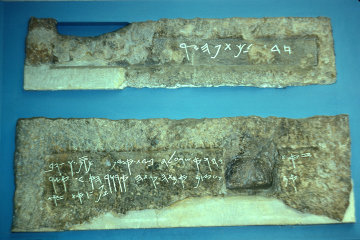
| |
| The Shebna Inscription in the British Museum, found over a tomb in Silwan or Siloam. |
This is what the lord Yahweh says: "Go, visit this treasurer, Shebna, who is comptroller of the household, and tell him, 'What is this? Who do you think you are? that you have carved out a tomb here like someone building a tomb on high and cutting out a house for himself in the rock? Yahweh ... will toss you like a ball into a far country. There you will die and your glorious chariots will become a disgrace to your master's house.'"
In 1953 the Israeli scholar N. Avigad examined an inscription that had been taken from over the doorway of a tomb in Silwan, in the Kidron Valley below the City of David. He proposed a reading of the archaeic Hebrew text which is now widely accepted as correct.
This is the tomb of ...iyahu who is comptroller of the household. There is neither silver nor gold here, only his bones and those of his slave-girl wife. Cursed be the man who opens this.
The title "over the house", which I have rendered as "comptroller of the household" is identical in both Isaiah and the inscription. Although the crucial first three letters of the name are missing in the hole visible on the right-hand side of the slab, there seems little doubt that "Shebna" is an abbreviation of "Shebeniah" or "Shebeniyahu" and most scholars accept that the ...iyahu of the inscription and Shebna, the holder of the same office, are the same person.
God's disapproval of the elaborate tomb is probably because such a grandiloquent tomb was beyond the financial reach of a slave, even a royal slave (after all, he hadn't bothered or been able to purchase his wife's freedom!) unless he had indulged in a good deal of corruption of one form or another.
Babylonian Exile
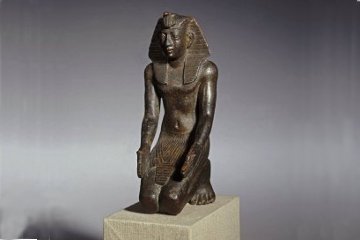
| |
| Kneeling statue of Pharaoh Necho, who tried to restore the Egyptian empire. |
Herodotus mentions with disbelief their report that after a certain point - in other words, as they rounded the Cape of Good Hope - the sun was on their right! In other words, they were south of the Equator, indeed, south of the Tropic of Capricorn and at noon, instead of being overhead or to their left - as it was in countries north of the Equator - the sun was off to the right.
A Babylonian document known as the Nebuchadnezzar Chronicle (or the Babylonian Chronicle) gives us the additional information that Necho campaigned in Syria between 609 BC and 605 BC, which is exactly confirmed by the statement in Daniel that Jehoiakim was conquered by Nebuchadnezzar in his third year: Necho appointed him as king following the death of Josiah in the disastrous Battle of Megiddo and that first year, 609/8 BC, was his "Accession Year". His official first year was 608/7 BC and his third year was 606/5 BC.
The Nebuchadnezzar Chronicle tells us, without fanfare, of an incredible feat performed by Nebuchadnezzar at the beginning of his reign, for his father, Nabopolassar, died in Babylon on August 15, yet by September 7 Nebuchadnezzar, who had been near Gaza when the news reached him, was back in Babylon. He must have galloped with a small party directly across the desert between Palestine and Babylon - a remarkable achievement in those days when there were no maps, no compasses and no roads.
The same document also mentions the capture of Jerusalem in 597 BC, referring to it as "the city of Judah" and records that the city fell on the 2nd of Addaru and that the king was captured.
In the seventh year in the month Chislev (Nov/Dec) the king of Babylon assembled his army, and after he had invaded the land of Hatti he laid seige to the city of Judah. On the second day of the month of Adara ( 16th of March) he conquered the city and took the king prisoner. He installed in his place a king of his own choice, and after he had received rich tribute, he sent them forth to Babylon.
The Bible tells us that the king taken prisoner was Jehoiachin and the "king of his own choice" was Zedekiah. Some have seen a contradiction in the fact that the book of Kings says that this happened in the 8th year of Nebuchadnezzar, whereas the Chronicle and the Biblical book of Jeremiah both say that it was the 7th year. Dr Edwin Thiele, in his Mysterious Numbers of the Hebrew Kings demonstrates that the book of Kings uses an autumn-autumn year whereas Jeremiah (and presumably the Chronicle) both use a spring-spring year.
This accounts for the apparent "extra" year. Nebuchadnezzar came to the throne in August 605 BC when his father died and the rest of the year was his Accession Year. According to the book of Kings, that Accession year ended in September or October 605 BC, whereas according to Jeremiah and the Chronicle the Accession year continued until March or April of 604 BC.
The fall of Jerusalem took place on the 2nd of Addaru or Adar, which corresponds to our February/March and thus falls within the period of overlap when Kings regarded it as Nebuchadnezzar's 8th year while Jeremiah - and the Babylonians themselves - still thought of it as his 7th year.
Jehoiachin's Rations
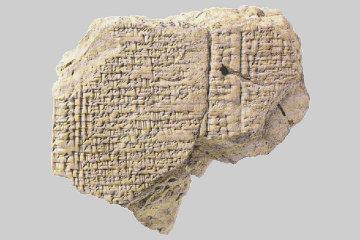
| |
| One of the cuneiform tablets which lists the rations given to Jehoiachin, king of Judah. |
Tablet 1
... to Ia-'-u-kin, king ...
to the qîpûtu-house of ...
... for Shalamiamu, the ...
... for 126 men from Tyre ...
... for Zabiruam the Lydian ...Tablet 2
10 sila of oil to ... [Ia]-'-kin, king of Ia-[a-hu-du]
2½ sila of oil to the five sons of the king of Ia-a-hu-du
4 sila to eight men from Ia-a-hu-da-a-a ...Tablet 3
1½ sila for three carpenters from Arvad, ½ sila each
11½ sila for eight ditto from Byblus, 1 sila each ...
3½ sila sila for seven ditto, ½ sila each
½ sila for Nabu-etir the carpenter
10 sila to Ia-ku-u-ki-nu, the son of the king of Ia-ku-du
2½ sila for the five sons of the king of Ia-ku-du through Qana'a
Note how the Babylonian scribes struggled with these outlandish foreign names, trying to represent them in the cuneiform symbols that gave the right sounds. "Judah" becomes three symbols "Ia", "ku" and "du" while poor old Jehoiachin becomes five symbols.
It would seem that the standard ration of oil - for lighting, cooking and putting on the body - was half a sila, so the fact that Jehoiachin gets 10 sila is an indication of the favour shown to him by the king. Of course, Jehoiachin wouldn't use that much oil himself - though there was room for extravagance there - and the fact that his sons are listed separately indicates that it wasn't all for his household. Probably he sold the excess, thus giving himself access to a certain amount of money.
Murashu and Sons
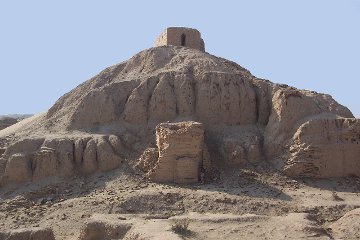
| |
| The ziggurat of Nippur, where the tel is 60' high and nearly a mile in diameter. |
One of the more interesting discoveries he made was a cache of 730 clay tablets that had been carefully placed in jars which were then sealed with bitumen. They turned out to be legal and financial documents relating to the banking activities of a certain Murashu, his three sons and his three grandsons. The family appears to have been active between 455 and 403 BC and their dealings included buying and selling land, making loans or providing financial guarantees (in one case for an imprisoned debtor), managing estates and properties for absentee landlords, and hiring out agricultural equipment such as animals, ploughs and even fishing nets.
Interestingly, many of their clients were fellow Jews and quite of few of these adopted Babylonian names or at least used Babylonian forms of their Jewish names. This same trend can be seen in another family of bankers whose tablets were preserved thanks to the lucky accident of their house burning down! The conflagration baked the tablets, thus preserving them for posterity. We know them as the House of Egibi, which appears to be the Akkadian transliteration of "Jacob", but the head of the firm was "Ittl-Marduk-balatu" and we only know that he was Jewish because he also used the name "Iddina", which is the Akkadian form of "Nathan"!
The presence of all these Jews in Mesopotamia confirms the Biblical story that large numbers of Jews were forcibly transported into Exile and that they were encouraged there to "seek the prosperity of the land" - in other words, to settle down and live peaceably in Babylonia rather than becoming some sort of underground resistance movement.
a virgin The Hebrew word used here simply means "young woman", though the connotation of virginity is present, rather like our English word "maiden". Unless the sign was of no value whatsoever, we must assume that shortly after Isaiah made this prophecy a young woman known to both men became pregnant and nine months later gave birth.
The idea that the prophecy refers to a virgin rather than a young woman comes from the LXX, where the Greek word for "virgin" is used. Whether the rabbis who translated the Old Testament into Greek were using some nuance for the Hebrew word with which we are unfamiliar, or whether they were simply seeking to impress their Greek patron, we cannot tell. It is, of course, possible that neither is correct and they were inspired to render the Hebrew in this way so as to provide a prophecy for the Messiah.
Some may object that the primary purpose of the prophecy was to give encouragement to Ahaz and that it had nothing to do with Jesus. While this is true, it is not entirely relevant. The Bible was written for people who did not share our concern with context and for them, taking the phrase out of context - which we would regard as misinterpreting it - was an entirely normal and rational method of interpretation. Return
Pekah was assassinated This is confirmed by Tiglath-pileser's terse note:
ReturnThey overthrew their king, Pekah (Paqaha), and I place Hoshea (Ausi) over them as king.
Shalmaneser V Samaria fell in August or September, Shalmaneser died in December, so it is clear that he was the ruler of Assyria who could claim to have conquered Samaria and, in fact, the Babylonian Chronicle notes the destruction of Shamrayin as the premier event of Shalmaneser's reign. Sargon II claims to have captured the city in his first year, so either he was lying pure and simple, or his memory became confused - for he makes the claim in a document dating from late in his reign, or - more likely in my opinion - he was the general in charge of the army which captured Samaria, so he did indeed capture the city during the calendar year in which he came to the throne. Return
evidences One line of "evidence" was linguistic. For example, the Cimmerians were supposed to be the ancestors of the Cymru or Welsh and were identified with the Lost Tribes. There is no merit in this suggestion. Another favourite was to trace the migration of the tribe of Dan by means of names such as "Danube" or "Danzig", which the proponents of the theory claimed were named after this tribe. It seems curious that the Danites should have been eager to give their name to so many geographical features while other tribes - Reuben or Gad - were remarkably reticent. Perhaps best of all is "British" which is supposed to mean "Man of the Covenant" - berith (covenant) and ish (man). As some wag has pointed out, Hebrew word order is different to English word order and if "British" really is derived from those two Hebrew words, it would mean "covenant of man", a fitting dismissal of a foolish theory. Return
dug a channel In fact there is such a channel, discovered in 1899 and known now as the Middle Bronze Channel. It is a ditch 20' deep and covered by stone slabs which were disguised by earth and foliage. It comes out near the pool of Siloam, but there are also several outlets that provide water to the gardens in the Kidron Valley. I have not personally investigated this channel but from the descriptions I have read I would take issue with the claim that it followed "a more direct route": it must have gone along the side of the hill and around the end of the Ophel Ridge. Return
taken to Istanbul Some years ago Dr Siegfriend Horn of Andrews University told me how he had visited the Istanbul Museum especially to view the inscription, only to be told that it had once more disappeared and the officials hinted that it had never been there in the first place. He persisted and eventually, because of his academic standing, was allowed to view the museum storerooms. He recognised the inscription among the clutter and when he pointed it out, the official remarked, "Oh, that? We were going to throw it out; we didn't know what it was."
I trust that the present museum curators are slightly better informed about the contents of their museum, but they certainly are no more responsible in their attitude towards their treasures. There are two archaeology museums round the back of the Topkapi Palace - the Archaeological Museum and the Hittite Museum - and frequently only one is open. When the Archaeological Museum is open, it is only the ground floor which is accessible to visitors. I have twice been there when the second floor is open and I was able to see the lower jaw of one of the serpents off the Platean Tripod from Delphi and the remains of the great chain that closed the Golden Horn. I have once been there when the third floor, which contains the Siloam Inscription and some quite important cuneiform tablets, was open. Needless to say, on those occasions the Hittite Museum, with its Hittite and Babylonian remains, was closed. Return
According to the prism The relevant part of the prism is as follows:
ReturnThe officials, nobles, and people of Ekron, who had thrown Padi their king, bound by oath and curse of Assyria, into fetters of iron and had given him over to Hezekiah, the Judean, who kept him in confinement like an enemy, their heart became afraid and they called upon the Egyptian kings, the bowmen, chariots and horses of the king of Meluhha [Ethiopia], a countless host, and these came to their aid, they offered battle. With the aid of Asshur, my lord, I fought with them and brought about their defeat. The Egyptian charioteers and princes, together with the Ethiopian king's charioteers, my hands captured alive in the midst of the battle.
Eltekeh and Timnah I besieged, I captured, and I took away their spoil. I approached Ekron and slew the governors and nobles who had rebelled, and hung their bodies on stakes around the city. The inhabitants who rebelled and treated Assyria lightly I counted as spoil. The rest of them, who were not guilty of rebellion and contempt, for whom there was no punishment, I declared their pardon. Padi, their king, I brought out from Jerusalem, set him on the royal throne over them, and imposed upon him my royal tribute.
As for Hezekiah the Judean, who did not submit to my yoke: forty-six of his strong, walled cities, as well as the small towns in their area which were without number, by levelling with battering-rams and by bringing up seige-engines, and by attacking and storming on foot, by mines, tunnels, and breeches, I besieged and took them. 200,150 people, great and small, male and female, horses, mules, asses, camels, cattle and sheep without number, I brought away from them and counted as spoil. Hezekiah himself, like a caged bird I shut up in Jerusalem, his royal city. I threw up earthworks against him. Anyone coming out of the city-gate, I turned back to his misery. His cities, which I had despoiled, I cut off from his land, and to Mitinti, king of Ashdod, Padi, king of Ekron, and Silli-bêl, king of Gaza, I gave them. And thus I diminished his land. I added to the former tribute, and I laid upon him the surrender of their land and fines, gifts for my majesty. As for Hezekiah, the terrifying splendour of my majesty overcame him, and the Arabs and his mercenary troops which he had brought in to strengthen Jerusalem, his royal city, deserted him. In addition to the thirty talents of gold and eight hundred talents of silver, gems, antimony, jewels, large carnelians, ivory-inlaid couches, ivory-inlaid chairs, elephant hides, elephant tusks, ebony, boxwood, all kinds of valuable treasures, as well as his daughters, his harem, his male and female musicians, which he had brought after me to Nineveh, my royal city. To pay tribute and to accept servitude, he dispatched his messengers.
Herodotus mentions him In this quote Herodotus refers to the whole of Africa as "Libya".
ReturnLibya is washed on all sides by the sea except where it joins Asia, as was first demonstrated, so far as our knowledge goes, by the Egyptian king Necho, who, after calling off the construction of the canal between the Nile and the Arabian gulf, sent out a fleet manned by a Phoenician crew with orders to sail west about and return to Egypt and the Mediterranean by way of the Straits of Gibraltar. The Phoenicians sailed from the Arabian gulf into the southern ocean, and every autumn put in at some convenient spot on the Libyan coast, sowed a patch of ground, and waited for next year's harvest. Then, having got in their grain, they put to sea again, and after two full years rounded the Pillars of Heracles in the course of the third, and returned to Egypt. These men made a statement which I do not myself believe, though others may, to the effect that as they sailed on a westerly course round the southern end of Libya, they had the sun on their right - to northward of them. This is how Libya was first discovered by sea.
609/8 BC Jewish years, like those of most other countries in the Middle East, began in the spring. That is why a Jewish year is given as two of our years: it began in the spring of 609 BC and ended in the spring of 608 BC. Return
February/March This throws light on a prophecy in the book of Jeremiah, who warned Jehoiakim that because he had burned the book of warning, his dead body would be cast out "in the day to the heat and in the night to the frost" (Jeremiah 36:30). Jehoiachin reigned in Jerusalem for three months and the siege of Jerusalem continued for three months, which implies that Jehoiakim was killed at the start of the siege - and if he was killed in battle against the Babylonians and his body fell outside the city, I don't suppose they were unduly concerned to give him a royal burial. Like other enemy soldies, his body was left to be devoured by the vultures and pariah dogs (the "burial of an ass" referred to in Jeremiah 22:19).
This would have happened three months before February/March - in other words, in December/January and at that time the weather in Jerusalem is noted for its hot, clear days, and cold, frosty nights. Return





